From The CRPG Addict
Prophecy of the Shadow
Date Started: 24 June 2019
Ranking at Time of Posting: (to come later)
Summary:
Prophecy of the Shadow is a “lite” RPG that takes inspiration from Faery Tale Adventure and recent Origin Systems games. A sole character, presented throughout the game from an axonometric view, is thrust into the world when his mentor is assassinated as part of a political purge of mages. As he grows in power and skill, he learns of a prophecy that foretells the return of an ancient enemy named Abraxus. In his quest to counter the prophecy, he kills an evil regent and restores a princess to her rightful throne. The world is small and easy to explore. RPG elements–including combat, inventory, and character development–are simplistic but effective for the scope of the game. Graphics are mediocre in quality but are thoughtfully drawn to create interesting scenes and scenarios.
****
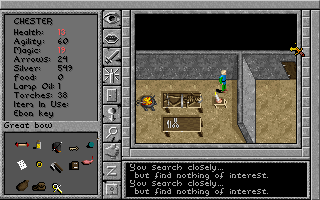 |
| I consider these good graphics–not because of the raw quality, but because of what they clearly depict. Such “scenes” are uncommon in RPGs even in the early 1990s. |
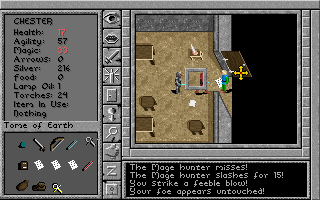 |
| Assaulting my way into Granite Keep. |
- The city of Jade
- The Fell Swamp
- Granite Keep
- The abandoned Silver Mine
- The city of Malice and its temple
- Abraxus’s Castle (I didn’t even know about this one until I teleported there for the endgame)
North of that was the Fell Swamp. I probably forgot to mention in previous entries that if you walk into a swamp in this game, you don’t get very far before an animation shows you drowning.
 |
| Entering the Fell Swamp at my own risk. |
For that reason, I had been circumventing the Fell Swamp, but I decided it must be there for some reason, so I took the time to experiment and soon realized that you could walk through the swamp on squares that depicted foliage. Following paths of these squares, I reached a hut at the center of the area. It was occupied by a powerful witch named Esme who said that she’d killed Tethe’s mage hunters.
As by now I was wont to do, I tried giving her my various objects. She had an immediate reaction to Larf’s head, saying that if she could assemble the ingredients for a potion of “Necrotelecomicon,” she could learn from him the secret of the resurrection spell. Fortunately, I had already picked up all the ingredients on her list: the fruit of the Desert Pango, the tongue of a Torlok chieftain, some spider venom, and a vial of acid, which apparently every “black potion” is.
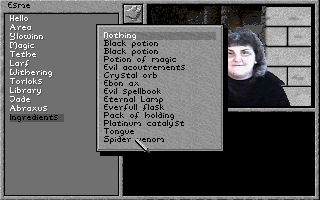 |
| I give the ingredients to Esme, who looks like a young Anne Ramsey. |
With these ingredients, she soon learned the “Respirare” spell and then immediately attacked me. I killed her in a few blows. I spent much of the rest of the game wondering what I would do with a resurrection spell since the game is single-player. I went back and tried to cast it on Larkin’s grave, but I got a message stating that I didn’t have a powerful enough catalyst.
I next headed for Granite Keep because I didn’t want to deal with the eye tyrants up near Malice. The keep’s front door had blocked me in the past, but some NPC had hinted at a side door, and sure enough, I soon discovered one. Using my Death Warrant got me inside, and I had to kill two guards right next to the entrance, a fight that occasioned about five reloads. The entire castle was very hard, with enemies whacking away 25 hit points per blow, and I began to wonder if there wasn’t some armor I might have missed. I had to rest frequently and gulp as often as possible from my “Everfull Flask,” a healing potion that regenerates every five minutes or so.
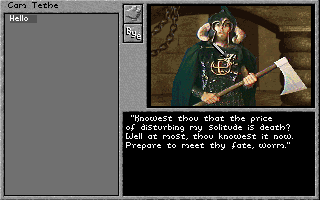 |
| If the penalty for everything is death, then you leave me with no incentive not to kill you. |
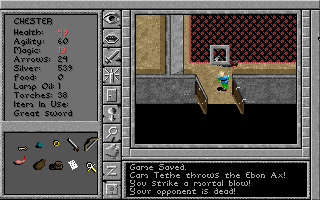 |
| Killing Cam Tethe on my fourth trip. |
To defeat him, I had to “door scum”: enter, attack him a few times, leave to rest and heal, save, and enter again. It’s worth mentioning that I had a “Time Stop” scroll that you’re almost certainly supposed to use in this fight, but I had forgotten about it. When Tethe died, he dropped a copper key and his ebon ax–a magic axe that returns when thrown.
The copper key opened the door in the dungeon, which released Princess Elspeth. I thought this would be the end of the game, but I realized I’d forgotten about the city of Malice. Elspeth gave me a key (that she’d palmed) to Tethe’s torture chamber, then fled to reclaim her throne. It’s worth pointing out at this time that the game world is not dynamic, and after Elspeth left, she was nowhere to be found. All NPCs reacted to her name as if she was still missing and as if Tethe was still alive.
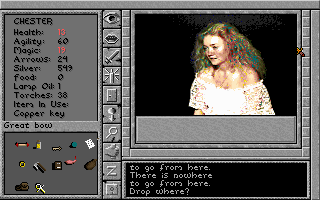 |
| The young princess, looking a little worse for the wear. She is played by an actress enigmatically named only “Kelly.” |
The torture chamber held a set of “evil accoutrements,” which turned out to grant me access to the temple of Abraxus in the city of Malice. Tethe himself wasn’t the shadow of the prophecy but merely the high priest of Abraxus’s cult.
After I left the Granite Keep and sold my excess equipment, I finally had enough money to purchase “acrobatics” training from Chester the Great and increase my agility. I also bought a potion that permanently increased my strength. Between these upgrades and the ebon ax, no combat in the game was really much trouble after this. Maybe some players manage to save enough money to get the agility increase earlier.
 |
| I admit, this guy looks like a “Chester.” Sometimes, I wish I’d picked a better pseudonym. |
On the way to Malice, I remembered the silver mines. I had a much easier time this time, and after some combats with gnomes, I found the Shadow Sword. The weapon negates magic when in your inventory and wipes your spell points if you wield it, so from the moment you find it, you have to go through an annoying process of dropping it and picking it up again every time you want to cast a spell.
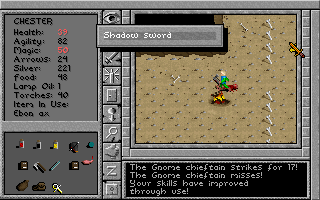 |
| Finding the Shadow Sword on the gnome king. This is not a weapon that you want any earlier than necessary. |
Malice had a handful of NPCs who praised Lord Abraxus and whatnot. The focus of the city was a large temple, where I killed a number of evil priests and walked out with a mysterious “Fan of Shadows” and a gold catalyst. I should mention at this point that from the various dungeons, I’d assembled several other spells, including “Cremare Magnus” (volcanic eruption), “Lamia” (steal life force), and “Umbra” (invisibility), none of which I ever found a reason to cast. I almost always needed to save my spell points for “Curare” (healing). I also never got much use out of the “Oculorum” spell or the redundant crystal ball, which shows your position in the context of a larger area. The larger area wasn’t really large enough to be useful.
The final area was reached via a teleporter north of the temple in Malice. I’d learned to watch for those pairs of rocks. They’re scattered all over the main island, but most of them just warp you a short distance from the origin. This final pair sent me to an island somewhere. A new monster called a “morgoth” attacked a few times, but it wasn’t very hard.
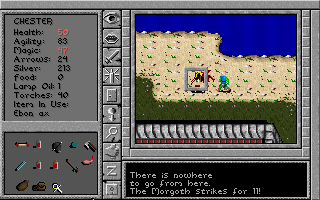 |
| This is one mean-ass morgoth. |
The island housed a large keep with four corner rooms and a pedestal in each room. Each pedestal had a riddle that discussed a certain element and prompted me for a particular object. I hadn’t realized I was saving the objects for this purpose, but it wasn’t hard to figure out where they went. The “Fan of Shadows” went on the air pedestal, the “Everfull Flask” on the water pedestal, the “Eternal Lamp” on the fire pedestal, and the “Wand of Earth” on the earth pedestal. When all four were placed, a door opened in a northern wall, taking me to the catacombs.
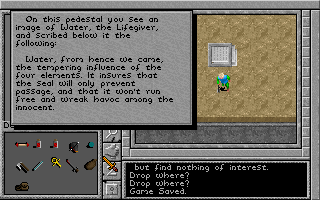 |
| Interpreting one of the pedestals. |
The catacombs had a brief battle with spectral priests before leading me to a bier on which the body of Abraxus lay in state. Even though it seemed like an absurd thing to do, since I couldn’t do anything but cast the “Respirare” spell on him, that’s what I did. The ancient sorcerer awoke, laughed at me, and attacked me.
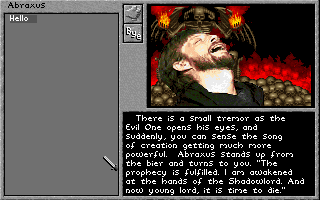 |
| I love how the hero’s one dialogue option for the insane resurrected sorcerer is “hello.” |
My hit points had been reduced by the ritual to 30, and as I fumbled about with my ebon ax, Abraxus swiftly killed me and, I supposed, took over the world. On reloads, I both discovered that only the Shadow Sword could damage him and remembered that I had two “Time Stop” scrolls. Through trial and error, I settled into a pattern of action: drop the Shadow Sword, resurrect Abraxus, use a “Time Stop” scroll, gulp all my healing potions, use another “Time Stop” scroll, pick up the Shadow Sword, and start hacking away. This sequence ultimately brought me victory over the sorcerer.
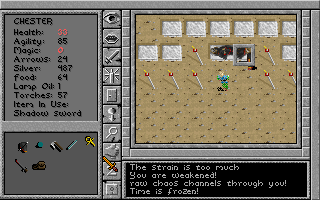 |
| Conserving those “Time Stop” scrolls was key to defeating Abraxus. |
The endgame was slightly reminiscent of Questron as the game showed my character marching through the halls of Granite Keep, NPCs arrayed around me, before I finally came to Princess Elspeth. She named me her Champion, Hero of the Land, Savior of the People, and announced a seven-day celebration. The ending text, cribbing from Casablanca, suggested even more rewards to come for our hero.
 |
| Lord British never offered to marry me. Just sayin’. |
All in all, a satisfying ending that leaves me feeling positive about the game. Prophecy won’t rate nearly as high as an Ultima, but in adopting Ultima as its model, the game provides a perfect example of the adage that if you aim for the moon, you’ll at least get over the fence.
In a GIMLET, Prophecy of the Shadows earns:
- 5 points for the game world. It tells a story commensurate with its scope, has a few moments of originally, and does a good job drawing you into the world graphically and textually.
- 2 points for character creation and development. Definitely not a strong category for the game. With only three attributes, each serving multiple purposes, there wasn’t much to develop, and there was virtually no creation process at all.
- 4 points for NPC interaction. While you do learn a lot about the land and its lore from NPCs, the system was very mechanical and featured no one with memorable personalities.
 |
| Um . . . where did that last line come from? |
- 4 points for encounters and foes. Enemies are mostly unmemorable, excepting perhaps the fireball-spewing gazers. But the puzzles were pretty solid, and I liked the large variety of what I call “contextual encounters”–when you’re given a clear reason for the combat to follow, even if you don’t get many role-playing choices in those encounters. I wish some of the lesser creatures had respawned because the economy is otherwise very tight.
- 3 points for magic and combat. I’m being generous here because I feel I should have probably experimented more with the spells. I did particularly appreciate the “Mark/Recall” pair. Aside from spells, the combat targeting system works fine but doesn’t give you very many tactics. Enemies rush into range so quickly that missile weapons are particularly useless.
 |
| Fighting a row of guards in Granite Keep. |
- 2 points for equipment. It’s hard to countenance at title that gives you nothing to wear or equip except a weapon. But there are a few additional potions and scrolls, and lots of items useful for exploration and quests.
- 4 points for the economy. Between regular equipment, food, potions, and agility training, you have plenty to save up for, and finding silver never becomes useless. You have to make some tough choices for most of the game.
- 2 points for a main quest with no options, alternatives, or side quests.
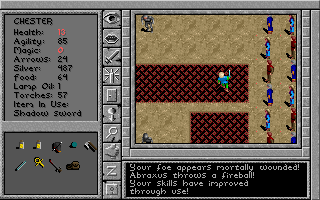 |
| The victorious champion walks past rows of NPCs on his way to his knighting. |
- 4 points for graphics, sound, and interface. The sound is nothing special–a few scattered effects–but as I’ve indicated, I like the graphics and the interface is top-notch, with redundant mouse and keyboard commands for everything. My only quibble is how using any other object un-equips your weapon.
- 5 points for gameplay. It gets half credit for nonlinearity. The game is mostly linear but not completely. I don’t see it as replayable, but the level of difficulty was pitched about right. Some individual combats seemed awfully hard, but in the context of a short game they weren’t too bad.
That gives us a final score of 35, right on the “recommended” threshold–a good score for a modest game of modest ambition.
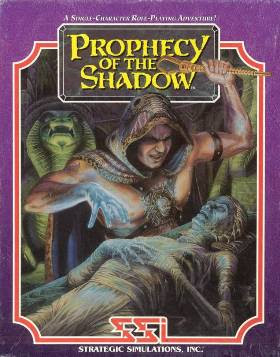 |
| Given what actually transpires in the game, the box seems to be depicting me waking up Abraxus. |
Almost every contemporary review of Prophecy seems to be patting it on the head, marking it as an interesting direction for SSI–the first single-character title from the publisher, a game clearly for new players, and so forth. Jeff James’s review in the January 1993 issue of Computer Gaming World praises it repeatedly for its simplicity: “no equipment to buy, no spells to memorize, and only one character to keep track of . . . no need to fumble with bizarre ingredients . . . byzantine game mechanics take a back seat to ease-of-use and an engaging storyline.” Similarly, from the Malaysian newspaper (who knew that they were reviewing RPGs?) that I quoted in a previous review: “[A]ctions are simple to execute . . . Gameplay could not be better. It’s just a question of taking things and bringing them somewhere.” The review concludes, however, “Just don’t give us any more recycled trash like Dark Queen of Krynn,” which shows that this source can be excluded from future consideration.
Almost everyone praised the full motion video, but I’ll let that go–it was a delusion that affected nearly everyone in the 1990s.
More recently, my colleague Saintus (who hasn’t commented in 3 years–hope he’s okay) completed the game in January 2012 on his “CRPG Revisiting Old Classics” blog. His review aligns with mine nearly perfectly. He liked the game world, the balanced economy, the short completion time, and the generally casual nature of gameplay. He didn’t find any more combat tactics than I did, nor any use for the crystal orb, nor much use for a lot of the spells. He defeated Cam Tethe the same way I did. The game kept his interest to the end despite simple mechanics.
A lot of contemporary reviews suggested that Prophecy was a new direction for SSI, that we’d be seeing a lot more single-character role-playing adventures from the publisher in the coming years. Scanning ahead, I can’t quite tell if this forecast comes true. SSI certainly offered a diverse variety of RPGs in its prolific 1992-1996 period, including the last of the Gold Box titles, the third Eye of the Beholder, new Dungeons and Dragon series based on the Spelljammer, Ravenloft, and Dark Sun settings, and a handful of one-off titles generally developed by other companies. But judging from screenshots and summaries, it’s hard to find any that feature quite the same simplicity as Prophecy or that even make use of a similar engine.
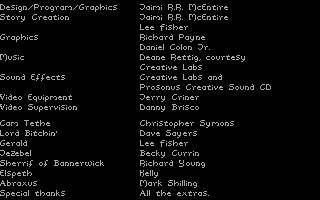 |
| Whatever else Dave Sayers went on to accomplish in life, he played “Lord Bitchin'” in a 1992 RPG. How do you follow that? |
Although I suggested in my opening entry that Prophecy was part of a deliberate SSI plan to dominate all corners of the RPG field, it turns out that the game’s development was less master-planned than that. It began as a project by independent developer Jaimi R. R. McEntire called Merchant’s Quest, in which the character would be a merchant in a traditional RPG setting. EA rejected it but SSI agreed to publish it. Ultimately, McEntire, working with an SSI team, significantly changed the original conception. Friends and a local theater group served as models for the FMV characters.
An Amiga version of Prophecy was planned and made it all the way to the alpha stage, but the team had problems working out several bugs, and just about then, the Amiga market began to collapse. Rather than finish the port, they turned their attention to the sequel–which would have brought the son of the original protagonist to a larger continent–but unfortunately never finished that, either. McEntire turned his attention to developing a raycasting engine called 4DX, used in a MMO called Underlight (1998) and several other titles. A new engine called 6DX was used to develop a title that would have been based on L. E. Modessit’s Recluce series, but it was never finished. Game development seems to have always been a sideline for McEntire: his c.v. shows primary employment in corporate software development, including banking software. Nonetheless, he told me in an e-mail exchange that he is working on a new RPG now, and making good progress. I trust he’ll visit to let us know when it’s ready.
It’s time now to wrap up Darklands and then head into the predictable comfort of a Gold Box game. But first–a surprise!
Original URL: http://crpgaddict.blogspot.com/2019/07/prophecy-of-shadow-won-with-summary-and.html

